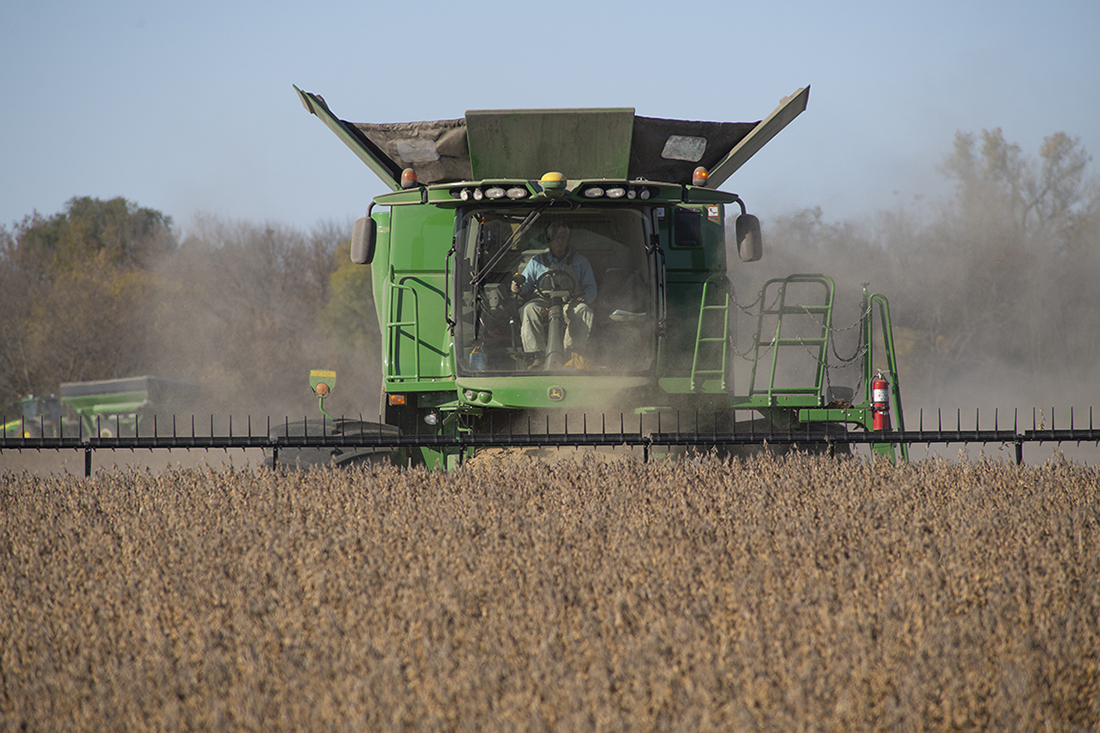
Rick Kimberley harvests soybeans during the 2019 season. Iowa soybean farmers produced 501.6 million bushels of soybeans in 2019. (Joseph L. Murphy/Iowa Soybean Association)
Report shows tighter soybean stocks, prices soar
October 1, 2020 | Bethany Baratta
By Bethany Baratta, senior writer
The U.S. Department of Agriculture’s (USDA) grain stocks report, released Sept. 30, showed smaller soybean and corn supplies than previously estimated.
Old-crop soybeans stored in all positions as of Sept. 1, totaled 523 million bushels, down 42% from September 1, 2019.
There were 101.97 million bushels of soybeans held on farm and off farm in Iowa as of Sept. 1, USDA said in its grain stocks report. Of those, 26 million bushels were stored on the farm; 75.9 million bushels were stored off the farm. Iowa soybean stocks were down nearly 36% from 2019, the report said.
USDA revised the 2019 U.S. soybean production 333,000 bushels lower than previously estimated. The total area planted to soybeans in the United States was unchanged at 76.1 million acres, but harvested area was revised to 74.9 million acres, down from the 75 million acres initially estimated. The 2019 average yield was unchanged at 47.4 bushels per acre.
Soybean prices bounced higher as a result of the USDA’s report. November soybean futures were 31 cents higher, closing at $10.24 per bushel. January soybean futures closed 33 cents higher at $10.29 per bushel.
Grant Kimberley, Iowa Soybean Association’s director of market development, said the downward revisions of the U.S. soybean crop had the greatest impact on market prices.
“Export and soybean crush numbers are known on a monthly basis, so that likely didn’t have as much of an impact on the market as the revision to 2019 production,” Kimberley said. Another factor, he said, could have been the loss of grain storage due to the Aug. 10 derecho.
Good news, bad news
Farmers sold old-crop soybeans based on information from the USDA that has since been revised.
“It’s unfortunate because it makes it harder for farmers to make good decisions on how to market crops based on information that’s not necessarily accurate,” he said.
However, the 30-cent jump in soybean futures provides some support in the market.
“It should mean a friendlier environment for positive pricing opportunities depending on external factors,” Kimberley said.
Continued sales to China, and whether announced export sales turn into actual soybean shipments will be factors to watch, he said. Growing conditions as South America begins planting their soybean crop could also affect their overall supply and sales when harvest begins in February/March 2021. The strengthening and weakening of global currencies also affect sales, Kimberley noted.
2019 production revised
Iowa soybean farmers produced 501.6 million bushels of soybeans in 2019, second only to Illinois at 532.4 million bushels. Iowa’s average yield was 55 bushels per acre, the highest in the nation.
USDA revised 2019 U.S. corn production 2.67 million bushels higher to 13.62 billion bushels. Iowa corn farmers produced 2.58 billion bushels of corn in 2019, with yields averaging the highest in the nation at 198 bushels per acre.
Contact Bethany Baratta at bbaratta@iasoybeans.com.
Back